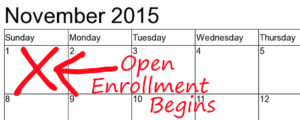Open enrollment for 2017 coverage starts on November 1, 2016. The schedule for open enrollment will follow the same November 1 – January 31 dates that were used last year (that schedule will continue to be used for 2018 coverage as well, but it will shorted to just a six week window in November/December for 2019 coverage, and will remain that way going forward).
 If you want your new plan to be effective January 1, 2017, you’ll need to complete your enrollment – on or off-exchange – by December 15. Over the last few years, there have been a series of extensions issued during open enrollment, but they were noticeably less prevalent during the most recent open enrollment, and we should expect to see them occurring with even less frequency this time around. Consumers, exchanges, and health insurers have had time to get used to the new systems by now, which means we should expect less flexibility on deadlines.
If you want your new plan to be effective January 1, 2017, you’ll need to complete your enrollment – on or off-exchange – by December 15. Over the last few years, there have been a series of extensions issued during open enrollment, but they were noticeably less prevalent during the most recent open enrollment, and we should expect to see them occurring with even less frequency this time around. Consumers, exchanges, and health insurers have had time to get used to the new systems by now, which means we should expect less flexibility on deadlines.
The maximum out-of-pocket limit on health plans for 2017 will be $7,150 for an individual, and $14,300 for a family (family plans have embedded individual out-of-pocket limits). That’s the upper limit though – there will still be plenty of plans available with out-of-pocket limits below those amounts. But plans with the lowest premiums will likely have out-of-pocket limits at or approaching those amounts.
If you want to read more, details about open enrollment and out-of-pocket limits are in the 2017 Benefit and Payment Parameters that HHS released earlier this year.
A note about HSAs
If you have a health savings account (HSA) – or plan to have one next year – and you want to be able to contribute to it in 2017, you’ll need to make sure that you enroll in an HSA-qualified HDHP (high deductible health plan) for 2017. HHS recently released the 2017 contribution limits and out-of-pocket requirements for HSA-qualified plans (Revenue Procedure 2016-28). For the most part, there are no changes from 2016, but there is one exception: the individual contribution limit for an HSA will be $50 higher in 2017, allowing an individual with an HSA to contribute – and deduct – up to $3,400. The family contribution limit will be unchanged, at $6,750.
And the maximum out-of-pocket limits for HSA-qualified plans will also be unchanged, at $6,550 for a single individual, and $13,100 for family coverage. Since the maximum out-of-pocket allowed under the ACA is increasing but the out-of-pocket limit for HSA-qualified plans is not, there will be a growing disparity between the two. HSA-qualified plans appeal to consumers for various reasons, but their primary draws are lower premiums than other plans, and the ability to fund an HSA – although the majority of people who have HSA-qualified plans do not have an HSA.
For consumers who wish to open or continue funding an HSA, HDHPs will likely continue to be an attractive option. But for consumers whose primary focus is on the lowest available premiums, there may be other plans in 2017 that are more attractive than HDHPs. That’s because plans that aren’t HSA-qualified (ie, that aren’t designated as HDHPs) will be able to have individual out-of-pocket maximums as high as $7,150, while those that are HDHPs will have to limit their individual out-of-pocket maximums to no more than $6,550 (in most cases, higher out-of-pocket limits are correlated with lower premiums).
Thus we can expect that there may be plan options available in 2017 that have lower premiums than the available HSA-qualified plans. But as with most things related to health insurance, there’s no one-size fits all when it comes to the most appropriate health plan for each person’s situation. Do keep in mind, however, that if your income is slightly above the subsidy-eligibility cutoff, you may find that contributing to an HSA results in a Modified Adjusted Gross Income that’s subsidy-eligible, making an HSA-qualified plan particularly attractive.
There’s a lot to consider when you’re selecting a health plan for the coming year. You can contact us in advance of open enrollment with questions, or to set up a phone appointment to complete your enrollment after November 1. As always, there’s never a charge for our services.


